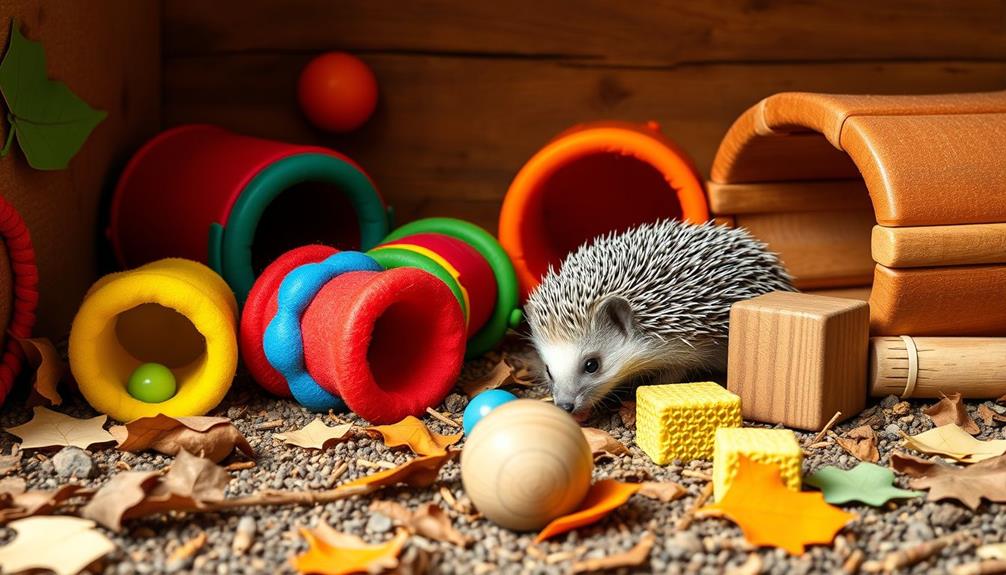As spring approaches, animals prepare by waking from dormancy, becoming more active and hungry. You might spot squirrels and raccoons rummaging for food in gardens. Birds are busy seeking early fruits and nesting materials. They defend their territories fiercely and establish boundaries with scent markings and calls. Migrating species travel to rich breeding grounds, often relying on flock flying to save energy. There's much more to discover about these fascinating behaviors during the season!
Key Takeaways
- Animals increase activity levels as spring approaches, driven by longer daylight hours and rising temperatures.
- Food-seeking behavior intensifies, with species foraging for seeds, fruits, and nuts to prepare for nesting.
- Hibernating animals awaken hungry and start searching for food immediately after emerging from dormancy.
- Territorial behaviors increase, with animals marking boundaries and defending resources against competitors.
- Migration patterns shift, with many birds traveling to breeding grounds rich in resources essential for raising young.
Increased Activity and Emergence From Dormancy
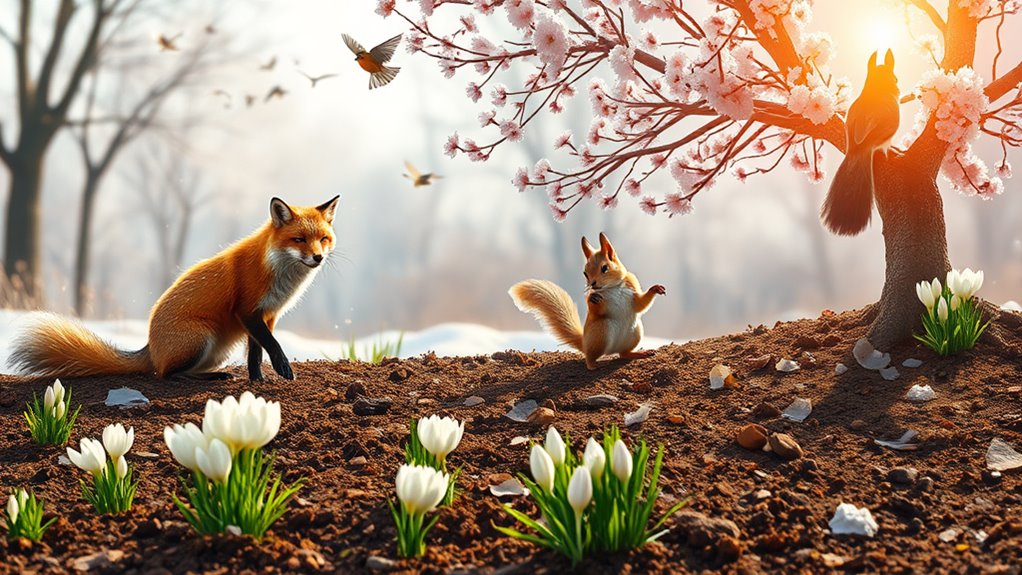
As spring approaches, you'll notice a surge in animal activity as they emerge from dormancy and respond to the warming weather. The longer daylight hours and rising temperatures invigorate many species, prompting them to explore their surroundings more frequently. Squirrels and raccoons become common sights in gardens and backyards, while birds fill the air with their distinctive songs, signaling mating and territory defense. Increased activity in search of food leads many animals to rummage through gardens and trash cans, seeking the nourishment they need to thrive after the long winter months. Hibernating animals, like bears, wake up hungry and often less cautious, leading them to venture into human areas in search of food. This increased visibility can spark more encounters between wildlife and people. As nature reawakens, you'll witness the vibrant interactions and behaviors that mark the beauty of spring.
Food Gathering Strategies in Spring
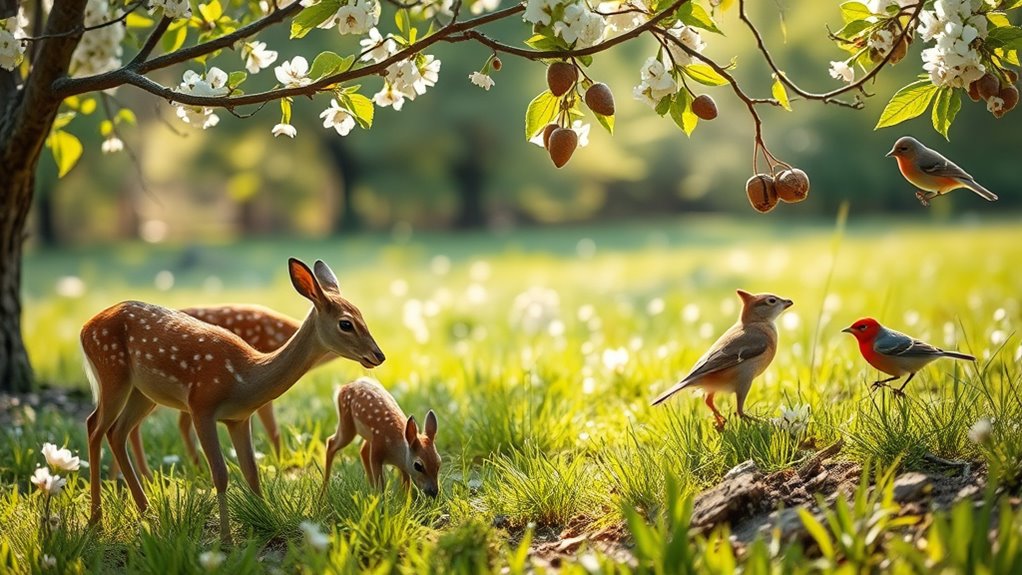
With the arrival of spring, animals adapt their food gathering strategies to take advantage of the season's bounty. You'll notice many species shifting their diets, capitalizing on the increased activity of insects and small animals. Birds, for example, seek out early fruits and berries, while small mammals forage for seeds and nuts. Some animals even migrate to areas rich in spring food sources; migrating birds require fast energy sources to support their long journeys. To maximize efficiency, social foraging becomes common, helping groups gather food more effectively. You can support these creatures by refilling bird feeders and planting wildflowers for pollinators. Remember, providing fresh water is essential, as natural sources may be scarce.
Nesting and Breeding Behaviors

Spring ignites a flurry of nesting and breeding behaviors among various animal species, as they respond to the lengthening daylight and warming temperatures.
Raccoons, squirrels, and birds seek out sheltered areas like attics and chimneys for safe nesting. Parrots prefer dark, hidden spots such as cabinets. As woodpeckers increase their activity, remember their nests are protected by law. During this time, many animals are also waking from hibernation, leading to increased wildlife activity in gardens and yards.
With spring rains stimulating plant growth, animals find plenty of food for their young. Hormonal changes in birds lead to heightened activity as they prepare and defend their nests.
Groundhogs and bats emerge from hibernation, while squirrels and chipmunks get busy in trees. Understanding these behaviors can help you coexist peacefully with wildlife during this vibrant season.
Territorial Behaviors and Resource Protection
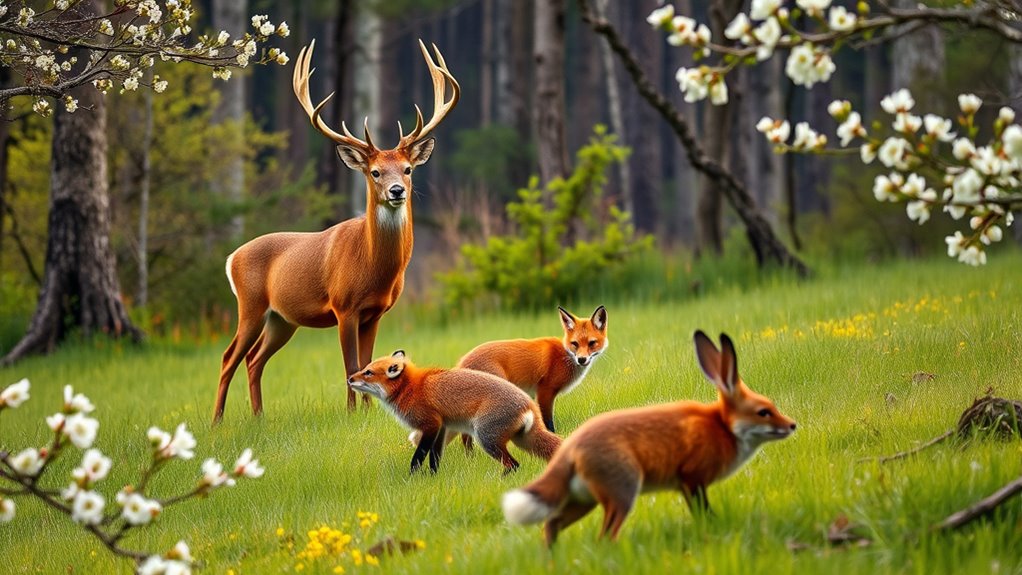
When animals awaken from dormancy, they become fiercely protective of their territories, driven by the need to secure crucial resources. Scent marking, visual displays, and auditory signals help them establish boundaries and deter intruders. As spring arrives, food becomes more abundant, leading to heightened competition. You might notice birds aggressively defending their nests or squirrels chasing off rivals to protect their feeding areas. Additionally, many species are actively foraging during this time, as new plant growth and insects become available. Raccoons and coyotes also exhibit strong territorial instincts, especially when they've young to safeguard. These behaviors not only maintain their access to essential resources but also guarantee their offspring's survival.
Migration Patterns and Movement Adaptations
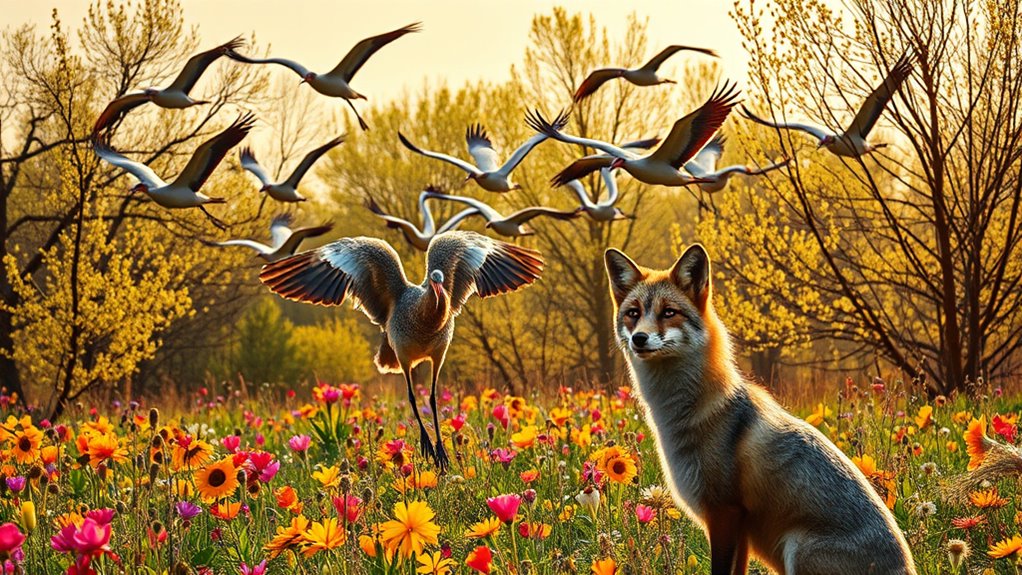
As animals fiercely defend their territories to secure resources, many also undertake migrations that signal the changing seasons.
Spring migration typically occurs from late February to May, with timing varying by species. For instance, ducks and robins often arrive in March, while loons and cranes follow in April. During this period, many birds migrate to breeding grounds rich in resources, utilizing diverse habitats along the way.
Spring migration unfolds from late February to May, with species like ducks and robins arriving in March, and loons and cranes in April.
Climate change's impact can disrupt these patterns, leading to mismatches with food availability. Birds migrate to breeding grounds rich in resources, utilizing diverse habitats along the way.
They often stop to rest and refuel, using energy-conserving strategies like flying in flocks. Cues such as daylight changes trigger migration, ensuring survival for those who adapt effectively.
These remarkable journeys highlight nature's resilience and need for adaptability amid shifting climates.
Frequently Asked Questions
How Do Animals Find Their Mates in Spring?
In spring, animals find their mates through various strategies.
You'll notice that male frogs croak loudly to attract females, while bluebirds flaunt their feathers. Some species engage in elaborate dances or territorial displays to demonstrate strength.
Many animals also rely on environmental cues like temperature and day length to signal mating season.
With food sources plentiful, the increased activity helps you spot potential mates, making the search for companionship more vibrant and competitive.
What Dangers Do Wildlife Face During Spring?
During spring, wildlife faces several dangers that you should be aware of.
Unpredictable weather can lead to sudden storms, causing stress and injury. Food scarcity may result in malnutrition, while increased predation risks threaten young animals.
Human activities like construction can disrupt habitats, leading to conflicts. Additionally, crowded conditions may facilitate disease transmission, putting entire populations at risk.
Being mindful of these factors can help you understand the challenges wildlife encounters this season.
How Can Homeowners Prevent Wildlife Conflicts in Spring?
Imagine your home as a cozy fortress, but even the sturdiest walls can crumble if not maintained.
To prevent wildlife conflicts this spring, seal entry points and secure vents. Trim branches that reach your roof, and store trash in animal-proof containers. Keep bird feeders at a distance and avoid feeding wildlife.
Regularly inspect your property for signs of wildlife activity, ensuring your fortress remains impenetrable and your home safe.
Are There Specific Signs That Spring Has Arrived for Animals?
You'll notice specific signs that spring has arrived for animals, like the return of birdsong and the emergence of frogs.
As temperatures rise, you'll see squirrels and chipmunks becoming more active, while hibernating animals like groundhogs wake up.
Look for blooming flowers and budding trees, as these visual cues indicate the season's change.
Keep an ear out for the cheerful chirping of peepers, signaling that life is returning to the environment.
How Do Changing Temperatures Affect Animal Behavior in Spring?
As the sun casts golden rays and the earth warms beneath your feet, you notice animals around you responding to changing temperatures.
You see squirrels darting energetically, bears emerging from their dens, and birds singing joyously.
These temperature shifts trigger hormonal changes, prompting mating behaviors and increased foraging.
You can't help but feel the vibrant pulse of life as animals adapt, ensuring their survival in the bustling symphony of spring.
Conclusion
As spring unfurls like a vibrant tapestry, animals awaken from their winter slumber, driven by instinct and the promise of renewal. You can almost hear the whispers of nature urging them to gather food, build nests, and protect their territories. Just like the legendary phoenix rising from the ashes, they embrace this season of growth and opportunity. So, next time you step outside, remember the remarkable adaptations of wildlife around you, each playing their part in this grand symphony of life.






